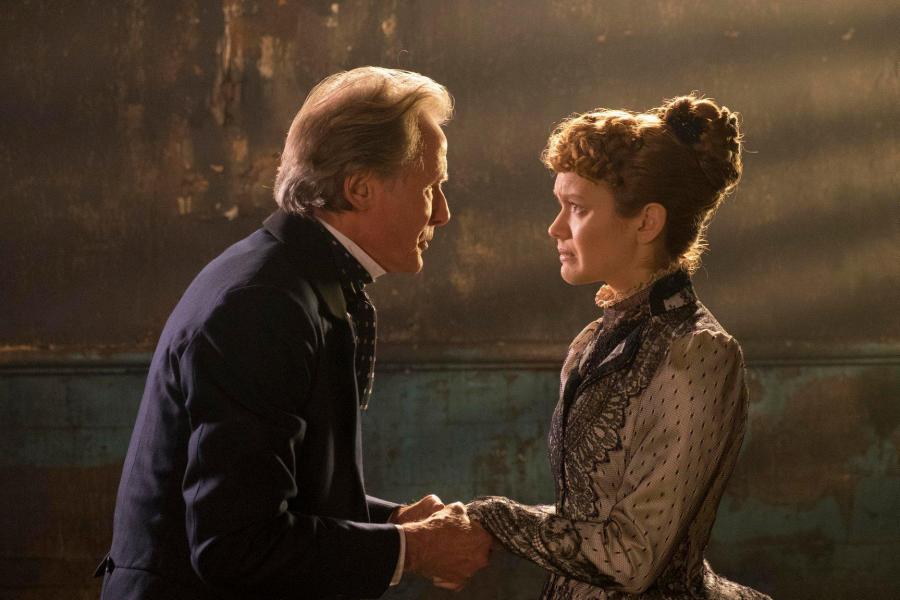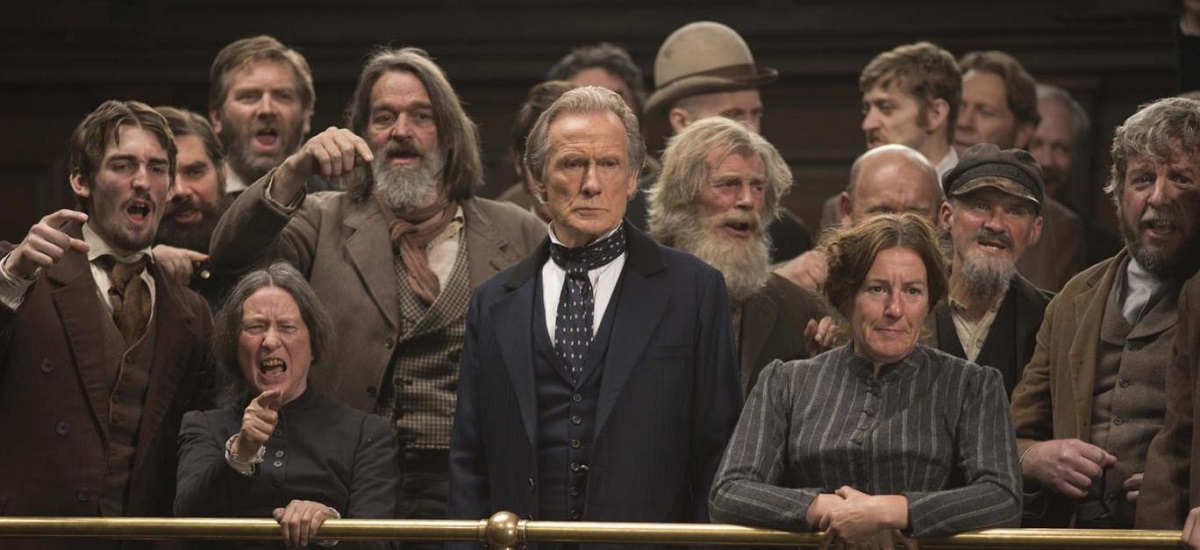Originally beginning life as a novel written by Peter Ackroyd, The Limehouse Golem feels distinctly literary. There’s a quality to Golem that seems as if best experienced in the form of a Penny Dreadful. Melodrama and menace ooze from every pore, thanks to stunning set design by Grant Montgomery, as well as an assist by subtle CGI backgrounds. Victorian London is easy to conjure in the mind, but here verve and dread pervade every interior, if only it amounted to something more than a passing fancy.
Set in London at the end of the 19th century, but predating Jack the Ripper, a less than desirable district called “Limehouse” has been beset by a series of grisly murders. Sensing the crimes may be unsolvable, while not wanting to tarnish their most seasoned detective, Scotland Yard is in need of a scapegoat. Enter detective inspector John Kildare (Bill Nighy). An intelligent man held back only by the rumors of his “nightlife,” he’s more than willing to take the assignment on the chin. Just as he settles in to his tenuous position, one of the main suspects ends up dead. Fortunately, the person accused of his death happens to be his wife, Lizzie Cree (Olivia Cooke), who may hold the key to figuring out who the Golem is. What follows is a twisty mystery through the fog swept streets of London. One that manages to rope in historical figures such as Dan Leno (Douglas Booth), George Gissing and even Karl Marx.
Just as he settles in to his tenuous position, one of the main suspects ends up dead. Fortunately, the person accused of his death happens to be his wife, Lizzie Cree (Olivia Cooke), who may hold the key to figuring out who the Golem is. What follows is a twisty mystery through the fog swept streets of London. One that manages to rope in historical figures such as Dan Leno (Douglas Booth), George Gissing and even Karl Marx.
The main aspect threatening to undo Limehouse Golem is timing. At around two hours, it pads the proceedings with more flashbacks and contrivances than are necessary. Were director Juan Carlos Medina able to hew closer to the obvious points of inspiration, like the Hammer & AIP horror films from the 60’s and 70’s, it would have been a resounding success. Those films often ran between 75-91 minutes, understanding a faster pace helped enrapture audiences. Trimming the fat may mean discarding some of Golem’s jaunty stops at the music hall, but it would have reestablished focus. As it stands, structure is a mess, relying on two main characteristics to bear the majority of the weight.
Surprisingly there’s a camp element that gets placed front and center, leading to some welcome extravagance. It pairs well with the music hall theatricality that plays an integral part in the proceedings. In fun move, Kildare imagines each suspect in various “what ifs” scenarios, as if they were the Golem. If anyone has ever wondered what a murderous Father of Modern Socialism would look like, here’s your chance.
Golem never truly bends or breaks, partially due to a stable of game actors. Eddie Marsan and Maria Valverde each stand out in small, but memorable parts as members of the Music Hall circuit. Cooke may be the most important character, in terms of story, but this is entirely Nighy’s film. He may not be the typical leading man, but his stoic nature and old horror features are perfect here. It’s rather easy to envision Peter Cushing relishing in this role back in the day. This is a compliment to Nighy, whose quiet, yet serious demeanor helps keep things from flying off the rails. Lizzie on a whole is a refreshing “go-getter” sort, overcoming physical and mental abuse. While partially a victim, she fights to never let a man stand in her way, even if many “white nights” attempt to come swooping in. Above all else, this feministic slant is one of the more interesting aspects on display. Olivia Cooke, after bursting onto the scene in Bates Motel, ping ponged in a couple less than great films. As Lizzie, she finds a role that allows her to give a strong performance. Often besting those she shares the screen with.
Lizzie on a whole is a refreshing “go-getter” sort, overcoming physical and mental abuse. While partially a victim, she fights to never let a man stand in her way, even if many “white nights” attempt to come swooping in. Above all else, this feministic slant is one of the more interesting aspects on display. Olivia Cooke, after bursting onto the scene in Bates Motel, ping ponged in a couple less than great films. As Lizzie, she finds a role that allows her to give a strong performance. Often besting those she shares the screen with.
For all the goodwill The Limehouse Golem doles out, it comes up lacking in the execution of the story. Jane Goldman has prepared a crackling script, in need of only the briefest of tweaks. Though having flashbacks alone aren’t an issue, more so the over-reliance on them is. It helps flesh in Lizzie’s background, which moves the plot forward. The problem it creates is that of tonal mishmash when it tries a hand at being self serious. What’s disconcerting is that it’s difficult to tell if this is specifically an issue inherent in the script, or due to wonky editing. The Limehouse Golem is held back only when it trips over its own feet. That’s not the worst thing in the world, considering it wants to stuff in a lot over its 100 minutes. While it may not be the pinnacle of Victorian slashers, there is still much fun to be had. With a smartly entertaining script, plenty of viscera and a handful of stellar performances, it’s not without its merits. Just like Kildare’s intuition, it narrowly misses the mark.
The Limehouse Golem is held back only when it trips over its own feet. That’s not the worst thing in the world, considering it wants to stuff in a lot over its 100 minutes. While it may not be the pinnacle of Victorian slashers, there is still much fun to be had. With a smartly entertaining script, plenty of viscera and a handful of stellar performances, it’s not without its merits. Just like Kildare’s intuition, it narrowly misses the mark.
SaveSave



